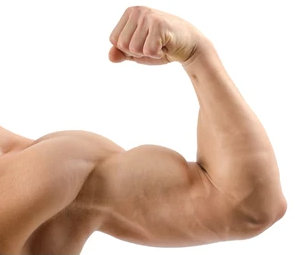If you're training with weights, you've probably already heard of working sets per muscle group. Do you know what this means? Clarify all your doubts about training in Depor Trainer .
What is a bodybuilding or strength work set
Surely your first trainer familiarized you with the basics of training in the gym . When you started bodybuilding, you realized that you had to do several sets per exercise, and that each training set consisted of several repetitions. However, for your training to be truly effective, you need to learn the differences between work sets, warm-up sets and approach sets.
The effective set is the real work of our bodybuilding or strength training. There are several repetitions of intensity, where we will move a load that will be a challenge (especially in the last repetitions). Effective sets are also called working sets. On these sets, we will be nearing or even going to failure on many occasions (muscle failure is when you can no longer complete one more rep with good form).
Warm-up sets are done with very light loads for several repetitions. These sets serve us to prepare the body for training. With the warm-up sets, we bring blood to the muscle and mobilize the muscles and joints. This set is important to start working on the movement pattern and to prevent injury in subsequent work sets.

The approach sets are performed after the warm-up sets and before the effective sets. With each approach set, we gradually increase the load and do few repetitions so as not to exhaust ourselves. The objective of the approach is to accustom our body to high weights before starting the work sets.
Now, we will see examples of effective sets and approximation so that everything becomes clearer. When you learn to use them correctly, you will get the most out of your weight training.
Example of training with work sets and approximation
Let's see a practical example of how the effective and approach sets are done in the bench press exercise. Suppose that our personal trainer has told us to do four sets with the following repetitions: 10, 8, 8 and 6. To complete the repetitions, we will have to choose weights that require effort and with which we reach near failure. For example, suppose we will do 10 repetitions with 70 kg, 8 repetitions with 75 kg, another 8 repetitions with 75 kg and 6 repetitions with 80 kg.

Warm up:
It is not recommended that we start directly with 70 kg without warming up and approaching. How will we carry this out? First, we'll do a set of 12-15 quick reps with just the bar. This sets will be a warm-up and will help us get the body used to the pattern of movement and pump blood to the muscles. In our assumption, the bar will weigh 10 kg.
We will rest for a couple of minutes and we will do a second warm-up set. We will place a 10 kg plate on each side of the bar (a total of 30 kg) to do about 8 fast repetitions. Here we would have finished our warm-up .
Approach:
Now, the approach sets begin. We will gradually increase the weight, but we will not do too many repetitions. We will place 15 kg more on the bar to have a total of 45 kg (counting the bar). With this weight, we will do 4 repetitions. This will be our first approximation sets.
We will perform a second approach set putting 15 kg more on the bar. There will be a total of 60 kg. In this approach set, we will do 2 repetitions.
We will rest between 3 and 4 minutes between the approach sets. After doing them, we will be ready to use the 70 kg of our first effective set in training.
Training scheme with warm-up, approach and working sets:
Warm up:
- • 10 kg x 10-12 repetitions.
- • 30 kg x 8 repetitions.
Approach :
- • 45 kg x 4 repetitions.
- • 60 kg x 2 repetitions.
Work sets:
- • 70 kg x 10 repetitions.
- • 75 kg x 8 repetitions.
- • 75 kg x 8 repetitions.
- • 80 kg x 6 repetitions.
This is the correct way to warm up the muscles and whenever we start a workout, we should do something similar, especially on the first exercise we do. This is very important because we start "cold".
The advantages of warming up and approximating before doing the first working set of bodybuilding
- • We prepare the body for intense efforts and prevent injuries.
- • We adapt our nervous system to lift high loads.
- • Thanks to the adaptation, we were able to get the most out of our work sets.
Why is it important that you learn to differentiate the work sets for hypertrophy?
The reason for this is that you will be able to get the most out of your weight training. Many people do not understand the difference between work and approximation sets. There is a very typical mistake that we have all fallen into when we started in the gym. For example, our coach tells us to do 4 sets of 10, 8, 8, and 6 reps respectively, and we consider warm-up sets to be work.
We could make the following mistake: do 10 repetitions with 50 kg, 10 repetitions with 60 kg, 8 repetitions with 65 kg, 8 repetitions with 70 kg and 6 repetitions with 75 kg.
If we go back to the example we gave before, we see that this is a poorly planned warm-up. We have done too many repetitions with 50, 60 and 65 kg, which are warm-up weights. Therefore, we arrive exhausted at 70 kg and we are only able to achieve 8 repetitions. If we had not exhausted all the energy in the warm-up, we would have been able to complete 70 kg x 10, 75 kg x 8, 75 kg x 8 and 80 kg x 6 as detailed in the previous example.
Remember :
- • Warm-up or approach sets are not effective or working sets.
- • Some coaches do not indicate warm-up or approach sets in their routines. They only indicate the effective sets. For example, if you have to do 4 x 10 with a challenging weight, you will first have to plan your warm-up and approach sets yourself.
- • Not doing warm-up or approach sets will make your actual work sets in the gym less effective.

Frequently asked questions about work sets for hypertrophy, strength, bulk and cutting
If you already know how to use the different types of sets, clarify your other doubts. Most of the users ask themselves the following questions.
How many warm up sets should I do and how do I increase weight in each set?
This really depends on your level in training and the loads you are going to move. As an example, it is not the same to do effective sets for quadriceps with 200 kg in squats than with 70 kg. The person who will work with 200 kg will surely need a higher warm-up. Let's see how this person should warm up to reach his working sets with examples :
- 10 repetitions with the bar alone.
- 10 repetitions with 60 kg.
- 5 repetitions with 90 kg.
- 4 repetitions with 120 kg.
- 2 repetitions with 140 kg.
- 1 repetition with 160 kg.
- 1 repetition with 180 kg.
- Effective sets with 200 kg.
However, the athlete who is going to work with 70 kg may only need to do the following:
- 10 repetitions with the bar alone.
- 8 repetitions with 40 kg.
- 5 repetitions with 50 kg.
- 2 repetitions with 60 kg.
- Effective sets with 70 kg.
As you can see, a heavier load requires more warm-up sets and more approaches. In addition, the jumps between approach charges will also be larger. The person who will move 200 kg can increase the weight in each set with jumps of 20 kg, while the person who will lift 70 kg increases 10 kg in each approach set.
On the other hand, you also have to consider the percentage of your RM with which you are going to work. The RM is the maximum weight that you can move in a single repetition for a certain exercise. To give you an idea, with 80% of your RM you can do about 10 repetitions, while with 50% of your RM you can do even 30 repetitions.
In some training programs, a job with 50% of the RM may be required, for example. In this case, the load you would use would be light. Therefore, you would not require too many approximations. Let's say your one-rep max for bench press is 100kg, and in your training program you have to do 30 explosive reps at 50% of your RM. A suitable warm-up could be the following:
- 12 repetitions with the bar.
- 8 repetitions with 30 kg.
- 4 repetitions with 40 kg.
- Effective set of 30 repetitions with 50 kg .
As you can see, since the weight is light on the work set, you don't need to do many approach sets. In conclusion, the number of approximations needed will also depend on how heavy the workload is going to be.

Is the same warming and approximation valid for everyone?
No. Actually, each person should use their own scheme of approximations. Not everyone is equally comfortable with the same weights and approach reps. Some lifters will be more comfortable doing one rep per set and others will prefer to do 4 or 5 reps.
What's more, even you yourself may prefer a different approach scheme for different exercises. For example, you may prefer more sets of approach in squats than overhead presses. Therefore, the warm-up is something very individualized and each one should find the one that best suits him through trial and error.
How many repetitions do you have to do in an approach set?
They usually do between 1 and 5 repetitions. For instance, 4 or 5 repetitions are done in the first approach sets and 2 or 1 repetitions in the last sets. Remember that if you do too many repetitions, you will deplete the energy you will need to give your all in your effective sets.
Do I have to warm up and approach in all the exercises?
The warm-up and approach are more important in the first exercise of your training because you start from scratch and you have not yet mobilized or activated the body. If you then do more exercises of the same muscle group with similar movements, you may not need to reapproach (because your body has already warmed up).
For example, if you've already done heavy sets of barbell bench presses and then need to do incline dumbbell presses, you won't need to warm up or approach again. You will be able to directly use the working weights in the dumbbell sets. Some people do prefer to do another small approximation with the dumbbells. This depends on the choice and sensations of each lifter.
Yes, it will be necessary for you to approach again if you are going to do an exercise for another muscle group. Suppose you've bench-pressed and now you have to do squats, an exercise with a totally different movement pattern and involving other muscles. In this case, you should again do a warm-up and approach for squat before moving on to effective or working sets.
Of course, your experience and time as a weightlifter will tell you when to approximate and when you can skip this step. Use different approaches and stick with the method you are most comfortable with.
Is it necessary to make approximations before the effective sets for strength?
Yes. Doing it here is even more important than in the work sets for bulking because the loads that will be handled will be greater. Typical routines for creating neural adaptations and approaching maximum strength follow a scheme like 3x3, 6x4, or 5x5 reps. The weights used to gain strength are higher and the risk of muscle injury or tear is greater.
We will see an example of warm-up and approximation before the working sets of strength. Our personal trainer has told us that we have to do 4 sets x 5 reps with 80kg on the bench press. How to warm up the muscles?
Warm up:
- • Barbell only x 10-12 reps.
- • 30 kg x 8 repetitions.
Approach:
- • 45 kg x 4 repetitions.
- • 60 kg x 2 repetitions.
- • 70 kg x 1 repetition
Effective sets:
- • 80 kg x 5 repetitions.
- • 80 kg x 5 repetitions.
- • 80 kg x 5 repetitions.
- • 80 kg x 5 repetitions.
This is an example of how to warm up before doing strength sets .
Should I do warm-ups and approaches before the work sets in cutting?
Yes. It doesn't matter if your goal is to gain muscle volume, muscle definition or strength. You should always do the approach, at least, on your first exercise or if you are going to do an exercise with a very different movement pattern in the middle of the routine (like in the example we gave of bench pressing and then squatting).
What are the maximum sets per muscle?

Ideally, the following maximum sets per muscle have been advised to gain hypertrophy.
- Between 14 and 20 sets of legs (counting quadriceps, hamstrings and calves).
- Between 12 and 14 sets of pectoral.
- Between 12 and 14 sets of dorsal.
- Between 12 and 14 sets for deltoids and trapezius.
- From 8 to 10 sets for biceps.
- From 8 to 10 sets for triceps.
- For abdominals and lower back, you can do some daily sets.
Remember that, when we refer to the maximum sets per muscle , only the working sets of exercise are counted . That is, if there are 14 effective sets for the shoulder, you will have to add the warm-up and the approach sets to these.
Final summary
An effective or working set is any set that is performed close to muscular failure. This set brings some kind of benefit or adaptation. It's a tough enough set to spark change.
The purpose of recording the reps and weights is to provide a goal for the next exercise. If you did each set with enough stimulus (near failure), you should be able to increase the reps or weight on the next workout. Your progress in the gym will be on the right track!
Before you start your first exercise set, you should do a few warm-up sets. A warm-up set is performed before a working set with lower weights and is not taken near failure nor does it represent a stimulus. The objective of a warm-up set is the following:
1. Warm up the muscles to use.
2. Practice the skill of the exercise that we are going to perform.
3. Give our brain time to recognize that we are about to do our best.
Each exercise in a program may require several warm-up and approach sets. Sometimes it is necessary to do many sets of low repetitions to approximate before using our working weight. Remember to start light and increase the weight until you reach the load you will use for your first working set. It will take you some time to get the hang of this process.
To finish, watch a video of Bilbo, a famous bench press lifter capable of moving more than 200 kg in the exercise. Here, he shows his approach sets during training.
Remember that the goal of the warm-up is to prepare you to lift the maximum weight in the working sets and to do it in the safest way possible.





![LAS MEJORES MÁQUINAS DE MUSCULACIÓN PARA PRINCIPIANTES [GUÍA 2025]](/modules//smartblog/images/no-home-small.jpg)
![HOW TO BUILD A HOME GYM ON A BUDGET [2024 GUIDE]](/modules//smartblog/images/296-home-small.jpg)


